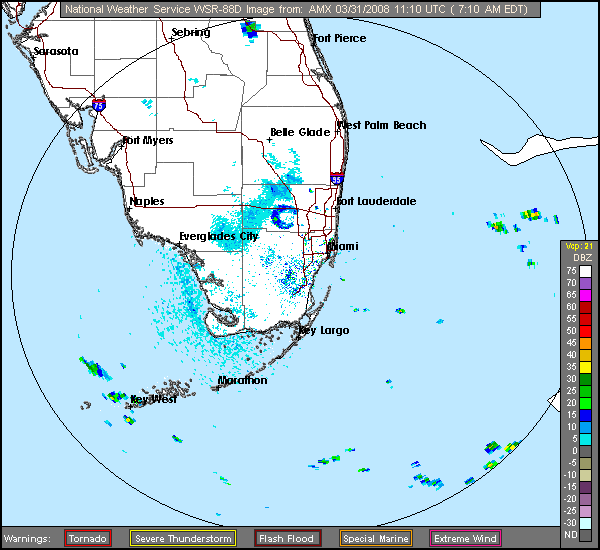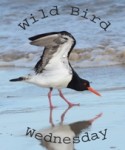Migration Radar “Donut” Echo
This Morning, Mary Lou and I were about to take a long walk, so I checked the Miami radar to see if there was any precipitation nearby. There was not, but I suspected that the radar had detected quite a few migrating birds. Since the loop was for the hour following sunrise, I thought that this was not likely, yet the echoes were suspicious looking.The specks did not track exactly with the prevailing southeasterly winds. One could imagine that a large stream of birds over the Gulf along the SW Florida coast were turning east, into the wind, to seek the safety of the land as the sun began to rise.
Most remarkable was something that looked like an expanding donut, with its center about 25 miles southwest of Fort Lauderdale. It exploded outward and westward from the northeastern corner of the Everglades Water Conservation Area (WCA-3) impoundment that is west of Okeechobee Highway (US-27) and south of Aliigator Alley (I-75).
This is what the “donut” looked like:

Here is the one-hour loop, beginning a little after 7:00 AM. Watch as the “donut” explodes:

I naturally turned to the expert, David LaPluma, aka BADBIRDZ, for his interpretation. His reply:
“Awesome- yeah- the birds that continued past the keys appear to have made landfall along the SW coast (probably into the coastal prairies and mangroves of ENP). The burst you’re seeing is birds leaving a roost… maybe a heronry.
“COOL!”
David provides much additional information about migration events during the night, and also a link to the area where the dawn flight originated– be sure to select the satellite (SAT) view to see the topography of the presumed rookery. Check out BADBIRDZ!
Mergansers do appear to be fishing cooperatively
Whenever at home, I keep an eye on the lake. You may call me a lake watcher, but for the past few days I have been studying the five Red-breasted Mergansers that are still circling around its edges. This morning, three species of herons, a Tricolored, a Little Blue Heron as well as a Snowy Egret, accompanied them on their rounds, sharing their catch. None of the three seem to feel threatened by others of different species, but the Tricolored drove away any other Tricolored Herons that tried to join the group.Late this afternoon the birds broke into two groups, or rather, as two of the birds decided to loaf and preen on a lawn across the lake, the other three resumed their clockwise cruise around the lake. Now only one heron, a Little Blue, was following along. I waited with my camera as they approached. It was about 6:00 PM, very cloudy and rather dark, but I staked out a position only about 20 feet from the lake’s edge as they approached our property.
The mergansers may have been simply encountering schools of fish in a random manner. However, I am quite convinced that they were fishing cooperatively, as they moved in a diagonal line, parallel to the shore, with the leading duck the farthest out, and the following birds diagonally nearer to the shore. This would tend to herd the schools of fish up against the shore. This sequence repeated itself many times, and I observed it again this evening.
Here they are about 10 feet offshore, with the trailing birds nearer to the shore than the leader:

The birds then converge nearer to the shore, move clockwise in a circle, and appear to be diving for fish:

The circle becomes quite tight, as a Little Blue Heron stands by patiently:

Now the three mergansers seem to be feeding:

A Visitor to our Patio
Yesterday afternoon an immature White Ibis took a liking to our back patio. It seemed curious when it saw us moving about inside and even walked over to peer in the window.
White Ibis, immature:
Visiting wetland boardwalks in Pembroke Pines
This morning, on our way to return a movie to the library, we stopped for a walk in a very pretty park (Anderson Dream Park) in Pembroke Pines. Not too active for birds, though we flushed a Brown Thrasher that allowed us a very poor portrait, and a Common Moorhen, who hogged the lens.
Brown Thrasher:
Common Moorhen at waterfall. Note the red mark on the uppermost part of the leg, a field mark that I had not noticed before. The park is beautifully landscaped and well-maintained.
This Common Moorhen shows off its large yellow feet while swmming:
A young Swamp Rabbit permitted us to approach quite closely. Its ears
appear shorter and its coat is darker than the cottontails up East:

A humongous rock-colored Iguana and its smaller green companion basked on a little island:

Small green Iguana:
Big gray Iguana, about 4 feet long. Note the huge dewlap and the prominent round sub-tympanic shield:

Red-eared Slider in the little pond:
Loggerhead Shrike:
We then drove a few blocks west on Sheridan and visited the boardwalk at the wetlands near Broward County SW Regional Library, still hoping to see another exotic Purple Swamphen. No luck again, but there was beauty there.
Gulf Fritillary on Pickerelweed blossom:

Red-winged Blackbird on reed:
I tried to get a picture during the third syllable of its “Conk-ra-lee” song, as that is when the bird extends it wings and expands the red and yellow epaulets:
Great Egret on the boardwalk railing:

This Green Heron kept flying just ahead of us as we walked along the boardwalk:

Then on to another boardwalk, at Chapel Trail Nature Center, a couple of miles west on Sheridan Road. Here I got a glimpse of an American Bittern that literally dissolved into the marsh vegetation right before my eyes. We also heard a House Wren and saw several nice Prairie Warblers. Best sighting was a Limpkin, that startled me by flying up from cover and promptly dropped out of sight, screaming at me whenever I moved. Obviously, the Limpkin could see me but it did not work the other way around. No more photo op’s.
 Update on the Rosy-Finches of Sandia Crest, New Mexico. The flag is waving– flocks of Rosy-Finches are still visiting the feeders at Sandia Crest House. Feeders to remain up until the end of March if bears don’t start appearing. Banding operations have been discontinued.
Update on the Rosy-Finches of Sandia Crest, New Mexico. The flag is waving– flocks of Rosy-Finches are still visiting the feeders at Sandia Crest House. Feeders to remain up until the end of March if bears don’t start appearing. Banding operations have been discontinued.
Cooperative Predation in Red-Breasted Mergansers
The Red-breasted Mergansers are still on our lake, and still cruising endlessly around its perimeter. Watching them closely caused me to form a hypothesis about their fishing technique. Is it possible that they are actually engaged in cooperative predation? This phenomena is not unusual in the animal kingdom. In Alaska, I actually watched a pod of humpback whales encircle and close in on a school of fish, then engage in a hearty feast. White Pelicans commonly do this as well, as do Harris’s Hawks and coyotes.
My reason for wondering about this is the stereotypical manner in which the flock of five mergansers circled the lake, sometimes clockwise and at other times against the clock. Almost always, one or two would lead the group, and the rest tailed off a little ways behind.
I displayed a photo of the leading duck, eyes under water, in yesterday’s blog post, which I reproduce here:
As they passed by our rear patio, the group coursed along quite rapidly, with heads or even half their bodies underwater. Suddenly, they would stop, and they would converge on a school of fish. The leading birds, which appeared to overshoot the school, would then retreat back in to join the others at the shoreline. (Of course, as I also noted, various combinations of the three species of herons would join them at that spot). The manner in which the trailing birds followed the leader was what made me realize that the group may not have simply been encountering random schools of fish. In fact, they often lined up in an irregular diagonal line, with the rearmost bird closest to the shore. Could they have been “herding” the fish?
Here are the two trailing mergansers in the group of five, mostly under water, and quite close to the shoreline. The Tricolored Heron is hurrying to keep up:

As I typed this, I thought of asking Google about it. I entered the search term “cooperative feeding in birds.” To my great surprise, one of the first hits was Cooperative feeding behavior in Red-breasted Mergansers, The Auk, October, 1965, Volume 82, number 4, Page 635, “General Notes,” in which Bayard H. Brattstrom of California State College at Fullerton made a similar observation. He stated that this behavior, while reported previously in cormorants, had never been described in mergansers.
“On the morning of 10 April 1963, at San Carlos Bay, near Guaymas, Sonora, Mexico, we saw seven Red-breasted Mergansers (Mergus serrator) behaving in a manner that suggested they were fishing cooperatively. The seven birds were feeding in a shallow arm of the bay in water less than 24 inches deep on an incoming tide. They swam in a loose line…, moving slowly, more or less in the same direction with their faces either under the surface (hunting?) or above it for short periods…
“When a hunting bird discovered a fish, it immediately gave chase, flapping its wings and running on the surface. The positions of the fish were apparently determined by the birds peering under the water at frequent intervals. As soon as one bird began a chase…, the others joined in the pursuit…, the nearby birds flapping and running along the surface, those more distant flying. In the few seconds it took the last bird to arrive, a semicircle was formed by the birds with the pursued fish in the center of the arc…
“As the birds chased the fish, one or another of them dived under the surface in pursuit, surfacing at about the time the others reached that spot. This diving continued in each case until one of the birds caught the fish. Immediately upon surfacing that bird would eat the fish. As soon as a fish was caught, the rest of the birds would begin to disperse and to hunt again. Presumably greater efficiency in fishing results from this type of cooperative feeding behavior, since a chased fish has a reduced number of escape routes, and more than one bird has the fish in vi ew at any given time…”
Photos of Late-Season Rosy-Finches
Yesterday, Jim Stuart of Albuquerque posted this note on the AZ-NM Bird List The Rosy-finches were still hitting the two feeders at Sandia Crest on Wed (26 March), perhaps 70 or so although I didn’t try to get a count. The flock seemed to cycle through about once every couple of hours. The restaurant manager kindly put a line of seed out on the deck which brought in a variety of birds plus an Abert’s squirrel for good viewing. The deck feeder tray is in a strangely awkward position for seeing anything.
All species including Hepburn’s form present. I managed to get some photos as they dashed around (see my Flickr.com link) although it was like photographing a swarm of mice. The Cox banding team seems to have gotten about every finch! If any of my ID’s on the photos are incorrect please let me know. Thanks.
Jim kindly permitted me to display several of his photos here. His birds are lined up almost as in a field guide, to permit ready comparison of plumage features. They all appear to be adult males, which makes identification easier. Early in the winter, some hatch-year birds and females can be more difficult to separate, as the gray crowns may not be as distinct and the black may not be as deep as now. Note, that as breeding season approaches, the bills of most turn from bright yellow and become darker, almost black. He certainly is right about all the bands (See: Saturation Banding)

Gray-crowned Rosy-Finch (Interior race):
Gray-crowned Rosy-Finch (Gray-cheeked Coastal or Hepburn’s race):
Black Rosy-Finch:

Brown-capped Rosy-Finch:

Florida Migration Radar
This morning, Badbirdz2 posted radar loops from late last night, showing flocks moving to Florida out of Cuba.
Badbirdz2 is Back!
The past couple of days we have had northerlies that were not favorable for migrants attempting to cross from Cuba northward.Finally the winds have subsided and shifted to southeast, and the backlog may start to clear, just in time for the return of Pepe (BADBIRDZ2), who will interpret the radar echoes for us. This evening at about 10 PM there were simultaneous departures of moderate waves of migrants from both the north coast of Cuba and from the Keys, despite the disturbances along the Keys.. Follow this spring migration on the Badbirdz2 site.Sharing the Table: Commensalism
Close-up of the Red-breasted Merganser who led the flock along the shore (March 27, 2008)
On March 25, I described how herons on our lake followed mergansers along the shore as they fished, and appeared to benefit from their proximity as fish were driven nearer the shoreline to escape the swimming predators. I have seen herons engage in similar behavior when cormorants were diving near shore. Others have related seeing herons actually attempt to grasp fish from the beaks of cormorants as they surfaced before trying to swallow them. One Florida birder saw a cormorant turn the tables and attack a Great Blue Heron that had just caught a fish.
It was almost like clockwork. As happened the first day, just as we were getting ready to eat supper, there was a commotion at the edge of the lake that caught my attention. This time there was only one merganser, with two herons, the Tricolored and the Little Blue, following along the shoreline. Again, I grabbed my camera and captured a few more images as they moved from right to left, clockwise around the lake.
The leading bird ducked its head underwater as it paddled rapidly

Actually, (presumably the same) five Red-breasted Mergansers, a species that I had never seen before on our little lake over four years of watching, had been out there earlier that day. Whereas on the previous day they were accompanied by a Tricolored Heron and a Snowy Egret, this time their shoreline companions were a Tricolored and a Little Blue Heron. Just as before, they were cruising along the shore with the herons following closely along.
This merganser is almost submerged in water only about 4 inches deep

I had been hoping for a photo opportunity, but had to wait until the evening encounter, because when they were about 5 doors down from our home, the mergansers decided to move across the lake. They changed direction in unison, and the heron promptly flew across the lake as if to greet them upon arrival on the other side. Instead of immediately resuming their fishing activity, the mergansers first engaged in about 20 minutes of vigorous bathing and preening. They flapped their wings so hard that I could hear them slapping on the surface like little outboard motors, and spray flew all about (I speculated that they may have been molting and were trying to shed old feathers).
They appeared to drive a school of fish towards the shore, where three mergansers and the heron fed together
In the meantime, both herons, who only moments previously had been feverishly running along the bank and catching fish stirred up by the fish ducks, seemed content to just sit and watch the show. They also preened and even looked as if they were falling asleep, as did the the mergansers, after they hauled up on the neighbor’s lawn to bask in the early morning rays of the sun.
Why were the herons wasting their time in such a manner? It was early in the morning and the lake’s surface was quite still. It seemed to be the ideal time for them to be out catching fish on their own and not just sitting there, waiting for the mergansers to stir.
Generally, the actions of wild creatures are purposeful. What they do has meaning. They do not waste energy. To do so is not in the interest of their survival, as individuals and as a species. Humans and pet dogs commonly engage in behavior that is not purposeful. We and they can afford to do so. Critters in the wild pay dearly if they do not put every hard-earned calorie into good use.
The heron had to fly to keep up with the feeding mergansers

When interpreting natural history in New Mexico, I would contrast the tracks left in the sand or snow by domestic dogs with those of wild canids. Fido goes here, then there, sniffs this tree, chases his shadow or his tail, leaps into a snow drift or puddle, almost as if enjoying it. Coyote or Fox walks sedately, or trots in a straight line, directly from one place where prey may be hiding, to another, then leaps, sprints and makes a kill, or at worst, a near miss.
Students asked me how to tell the difference between dog and coyote tracks. They had to learn the “Three P’s.”
First the PRINT itself, robust, crisp and short-nailed in the coyote, but elongated and usually long-nailed and scuffed in the pet.
Second, PERFECT STEPPING; when walking, the coyote disturbs the surface of the ground, snow or leaf litter as little as possible by placing its hind foot in the same spot as its forepaw. Dogs walk a bit sideways, as if their carriage is out of alignment. Sometimes it seems their back legs want to catch up with and pass their front ones.
Finally, as mentioned, the coyote tracks show PURPOSE. They are directed at performing some survival-related task quickly and efficiently. This is not to say that wild animals do not sometimes engage in what we humans would call “play.” Yet even when coyote pups appear to be having fun, chasing and tumbling with one another, they are cementing bonds and establishing skills, rank and boundaries that will enhance their survival.
The behaviors of the herons and mergansers were related in some meaningful way. They were engaged in commensalism, meaning that the herons were deriving a benefit from the activity of the mergansers, without causing the latter any harm.It made more sense and was more efficient in terms of energy expenditure for the herons to simply wait until the ducks resumed their fishing forays along the edges of the lake.
On the morning of March 27, all five mergansers were still circling the lake, this time counterclockwise. I planned for their next pass and set up the camera. The photos on the page were all taken at that time.
This appears to be a male in non-breeding plumage

This one had a longer crest and white chest, probably another male
Arizona Great-Grandchildren
Just in– these are Easter pix of two of our daughter Karen’s step-grandchildren. They call her “Grandkaren.”Bella and Liam play Ring-Around-The-Rosie with “Grankaren”

Get ready– “All fall down!”

Wearing their Easter finery for an egg hunt out on the farm
A prize for Liam
Liam has made a big egg haul! What a handsome guy!!!
 Update on the Rosy-Finches of Sandia Crest, New Mexico. The flag is waving– flocks of Rosy-Finches are still visiting the feeders at Sandia Crest House. Feeders to remain up until the end of March if bears don’t start appearing. Banding operations have been discontinued.
Update on the Rosy-Finches of Sandia Crest, New Mexico. The flag is waving– flocks of Rosy-Finches are still visiting the feeders at Sandia Crest House. Feeders to remain up until the end of March if bears don’t start appearing. Banding operations have been discontinued.
Letters from Sandia Crest
Fran Lusso & Dave Weaver, who coordinate the rosy-finch feeding project at Sandia Crest House, sent this note today:Hi Ken,
Just back from the Crest - road is clear but there is still snow on the ground in the forest and up at the Crest. Birders up there when we arrived said they had seen a flock of about 50. We urged them to make a log entry before they headed down - I think they will. There are still sightings of a large flock (~150) so the birds are still around. Weather is warming significantly out here - 70’s in town today and expected throughout the week. Hope all is well there!
Regards,
Fran & Dave
This report from this past weekend was posted on the Arizona New Mexico bird chat, from Devin Eby-Bosler of LSU-Baton Rouge:
For those interested, all three rosy-finches continue to frequent the feeders at the Crest House on Sandia Crest (Bernalillo Co.). As of Sunday (23 Mar), a fairly large mixed-species flock of ~120 rosy-finches made a few visits to the feeding station throughout the morning. The flock was comprised of ~60 Brown-cappeds, ~45 Gray-crowneds (including at least 6 Hepburn’s), and ~15 Blacks. The adult males are especially striking at this time having acquired their brilliant breeding plumage. The rosy-finch banding crew, headed by Steve and Nancy Cox, was there wrapping up the fifth winter season of banding. The team was busily trapping, banding, and processing rosy-finches throughout the morning. It’s fascinating to see these vividly-patterned fringillids up-close in the hand. Congratulations on yet another successful year of rosy-finch banding at the crest! Although the rosy-finch numbers are starting to thin out now, it’s not too late to stop by and enjoy the show. In past years, they have been reported through the first week or so of April.
Long Key Natural Area
There is an active rookery with the nests of Great and Snowy Egrets, Anhingas, and Tricolored Herons. We suspect that other herons such as Little Blue may nest there. A Wood Stork and White Ibises were also present.
The Great Egrets were decked out in nuptial plumes.

This closeup of the Great Egret’s head shows the green breeding coloration of the bare parts..

Tricolored Heron was gathering twigs as its mate waited on the platform of a nest under construction.

This Great Egret was sitting close on the nest, probably still incubating.

This Great Egret was tending to two very young hatchlings.

The magnificent Live Oaks were festooned with Ressurection Ferns and Bromeliads. This appears to be a Cardinal Airplant.

Apple Snail egg cluster in the pond next to the Interpretive Center.

On the way home we made a brief stop at the SW Regional Library wetlands in Pembroke Pines. We saw this Male Boat-tailed Grackle calling and displaying.

The object of his affection was a Female Boat-tail.
April 11-13, 7th ANNUAL PRAIRIE CHICKEN FESTIVAL in Milnesand, NM. Information available at www.wildlife.state.nm.us The contact The number of participants is limited to 100 people. |
May through October, TUESDAY MORNING GUIDED BIRD WALKS Birders meet at 8:00 a.m. (8:30 in May and October) at the |












